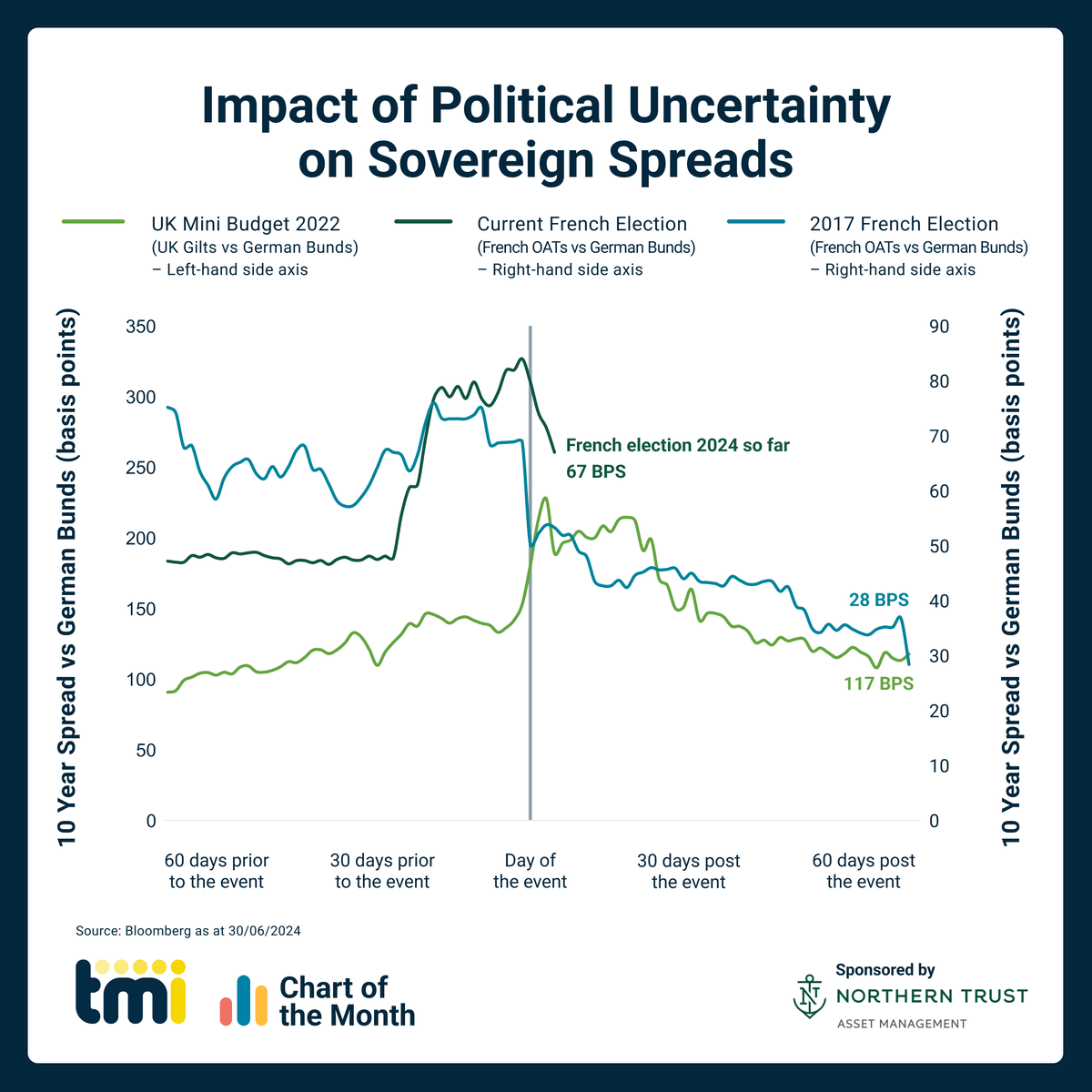

- Daniel Farrell
- Head of International Fixed Income, Northern Trust Asset Management
Exclusive insight for TMI subscribers! Northern Trust Asset Management share a monthly market commentary for treasurers.
Eurozone Market Update
The ECB concluded its June meeting with a cut of 25 bps across its three key interest rates. It became the second G7 central bank to ease policy this cycle after Canada, which also eased in June. The ECB Governing Council felt that a less restrictive policy stance was warranted by its updated assessment of the inflation outlook, underlying inflation dynamics and the strength of monetary policy transmission. The ECB reiterated their commitment to its data-dependent approach and stressed in its policy guidance that it “is not pre-committing to a particular rate path”. We view the hurdle for a July rate cut as extremely high and see September as the earliest the ECB could cut again. The announcement on 9 June of a snap election in France triggered a surge in the risk premium on French assets, with the spread between 10-year French OATs (government bonds and 10-year bunds rising by 28.6 bps over that week (See Chart of the Month). However, French markets responded positively after the first round of voting in which no party claimed a majority.

Source: Bloomberg, data as of 28 June 2024
UK Market Update
As widely expected, the BoE kept the bank rate at 5.25%, with the voting pattern unchanged. Seven members voted to maintain the current rate, while two voted for a cut of 25 bps. The decision was considered dovish because the meeting minutes noted that it was “fairly balanced” as the BoE downplayed the impact of services inflation surprises with their expected outlook. The minutes emphasised the drop in Consumer Prices Index inflation from 3.2% in March to 2.0% in May and noted that indicators of short-term inflation are expected to moderate. Following the meeting, markets increased the chance of a cut by the August meeting to 62% from 34%. We see a summer cut of 25 bps as the most likely scenario, followed by an additional 25 bps cut in the fourth quarter.

Source: Bloomberg, data as of 28 June 2024
US Market Update
The Federal Open Markets Committee (FOMC) left the target range for the federal funds rate unchanged at its June meeting. The statement was also mainly unchanged, with a small adjustment to the adjective of “modest” progress towards the committee’s inflation goal. While the outcome was expected, the market was more interested in the new release of the Summary of Economic Projections. This saw the central tendency of GDP growth revised down to 1.9%-2.2% from 2.0%-2.4% and core personal consumption expenditures inflation revised noticeably higher to 2.8%-3.0% from 2.5%-2.8%. The FOMC’s rate expectations moved from three cuts to two cuts for 2024. Consumer price inflation continues to moderate, with the monthly headline figure unchanged and the annual figure dropping to 3.3%. The core component rose just 0.2%, the softest since August 2021, with the annual increase down to 3.4%.

Source: Bloomberg, data as of 28 June 2024
Looking Ahead
The June rate cuts by the ECB and Bank of Canada suggest a monetary easing cycle is starting, contingent on inflation decreasing. We still believe the Fed and BoE will likely cut rates in the coming months. In the U.S., inflation and the labour market are key focuses. Despite some soft spots in the labour market, job gains are still well above the breakeven rate for the economy. We expect inflation to continue to get closer to the Fed target by the end of the year. Therefore, we still expect two cuts this year. The ECB’s data-dependent approach emphasises domestic inflation drivers such as wages, productivity and profit margins. We continue to expect the ECB to cut two more times in 2024, with cuts totalling three for the year. Finally, the BoE’s ‘cherry-picking’ of data highlighted their dovish inclination. A summer cut of 25 bps remains our base case, followed by an additional 25 bps cut in the fourth quarter.
Chart of the Month

Source: Bloomberg as of 28 June 2024
IMPORTANT INFORMATION
For Asia-Pacific (APAC) and Europe, Middle East and Africa (EMEA) markets, this information is directed to institutional, professional and wholesale clients or investors only and should not be relied upon by retail clients or investors.
The information contained herein is intended for use with current or prospective clients of Northern Trust Investments, Inc (NTI) or its affiliates. The information is not intended for distribution or use by any person in any jurisdiction where such distribution would be contrary to local law or regulation. Northern Trust Asset Management’s (NTAM) and its affiliates may have positions in and may effect transactions in the markets, contracts and related investments different than described in this information. This information is obtained from sources believed to be reliable, its accuracy and completeness are not guaranteed, and is subject to change. Information does not constitute a recommendation of any investment strategy, is not intended as investment advice and does not take into account all the circumstances of each investor. This report is provided for informational purposes only and is not intended to be, and should not be construed as, an offer, solicitation or recommendation with respect to any transaction and should not be treated as legal advice, investment advice or tax advice. Recipients should not rely upon this information as a substitute for obtaining specific legal or tax advice from their own professional legal or tax advisors. References to specific securities and their issuers are for illustrative purposes only and are not intended and should not be interpreted as recommendations to purchase or sell such securities. Indices and trademarks are the property of their respective owners. Information is subject to change based on market or other conditions.
All securities investing and trading activities risk the loss of capital. Each portfolio is subject to substantial risks including market risks, strategy risks, advisor risk, and risks with respect to its investment in other structures. There can be no assurance that any portfolio investment objectives will be achieved, or that any investment will achieve profits or avoid incurring substantial losses. No investment strategy or risk management technique can guarantee returns or eliminate risk in any market environment. Risk controls and models do not promise any level of performance or guarantee against loss of principal. Any discussion of risk management is intended to describe NTAM’s efforts to monitor and manage risk but does not imply low risk.
Past performance is not a guarantee of future results. Performance returns and the principal value of an investment will fluctuate. Performance returns contained herein are subject to revision by NTAM. Comparative indices shown are provided as an indication of the performance of a particular segment of the capital markets and/or alternative strategies in general. Index performance returns do not reflect any management fees, transaction costs or expenses. It is not possible to invest directly in any index. Net performance returns are reduced by investment management fees and other expenses relating to the management of the account. Gross performance returns contained herein include reinvestment of dividends and other earnings, transaction costs, and all fees and expenses other than investment management fees, unless indicated otherwise. For additional information on fees, please refer to Part 2A of the Form ADV or consult an NTI representative.
Forward-looking statements and assumptions are NTAM’s current estimates or expectations of future events or future results based upon proprietary research and should not be construed as an estimate or promise of results that a portfolio may achieve. Actual results could differ materially from the results indicated by this information.
Hypothetical portfolio information provided does not represent results of an actual investment portfolio but reflects representative historical performance of the strategies, funds or accounts listed herein, which were selected with the benefit of hindsight. Hypothetical performance results do not reflect actual trading. No representation is being made that any portfolio will achieve a performance record similar to that shown. A hypothetical investment does not necessarily take into account the fees, risks, economic or market factors/conditions an investor might experience in actual trading. Hypothetical results may have under- or over-compensation for the impact, if any, of certain market factors such as lack of liquidity, economic or market factors/conditions. The investment returns of other clients may differ materially from the portfolio portrayed. There are numerous other factors related to the markets in general or to the implementation of any specific program that cannot be fully accounted for in the preparation of hypothetical performance results. The information is confidential and may not be duplicated in any form or disseminated without the prior consent of NTAM.
This information is intended for purposes of NTI and/or its affiliates marketing as providers of the products and services described herein and not to provide any fiduciary investment advice within the meaning of Section 3(21) of the Employee Retirement Income Security Act of 1974, as amended (ERISA). NTI and/or its affiliates are not undertaking to provide impartial investment advice or give advice in a fiduciary capacity to the recipient of these materials, which are for marketing purposes and are not intended to serve as a primary basis for investment decisions. NTI and its affiliates receive fees and other compensation in connection with the products and services described herein as well as for custody, fund administration, transfer agent, investment operations outsourcing and other services rendered to various proprietary and third party investment products and firms that may be the subject of or become associated with the services described herein.
Northern Trust Asset Management is composed of Northern Trust Investments, Inc. Northern Trust Global Investments Limited, Northern Trust Fund Managers (Ireland) Limited, Northern Trust Global Investments Japan, K.K, NT Global Advisors, Inc., 50 South Capital Advisors, LLC, , Northern Trust Asset Management Australia Pty Ltd, and investment personnel of The Northern Trust Company of Hong Kong Limited and The Northern Trust Company.
NOT FDIC INSURED | MAY LOSE VALUE | NO BANK GUARANTEE
© 2024 Northern Trust Corporation. Head Office: 50 South La Salle Street, Chicago, Illinois 60603 U.S.A.




